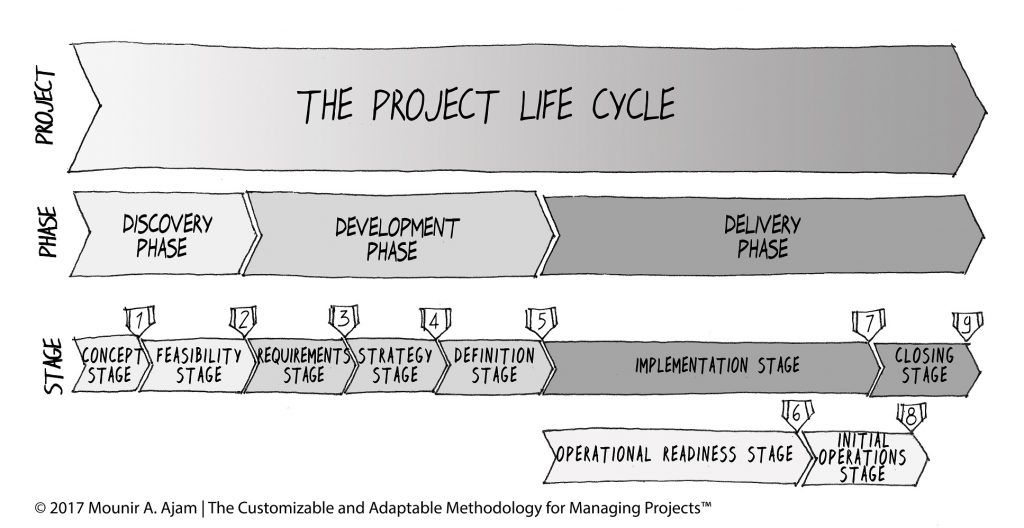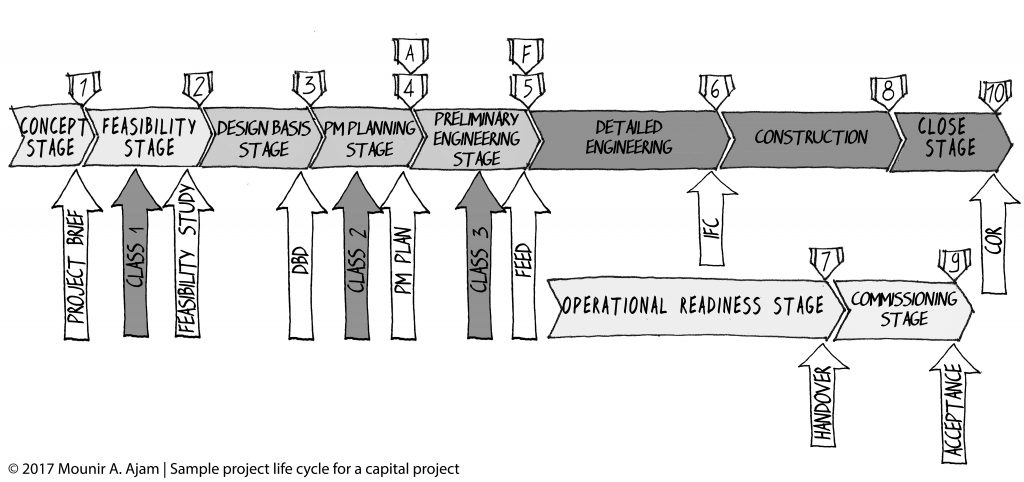A recent post on the project life cycle has been generating quite a bit of interest and discussion on LinkedIn. The post is “Once again, what is the project life cycle?”
Well, in this follow-up article, we will highlight some of the confusions that remain and present a few project life cycle examples.
Fixed or Variable?
In our view, references from PMI, ISO, and IPMA did not offer us much focus on the concept of project life cycle or offer a standard model. They touched on the theory and high-level concept of what a life cycle should be but did not offer in-depth coverage or examples.
Why?
Because project life cycles are not generic or fixed. They are variables. What we mean is that the project life cycle from one industry to another will definitely vary. Even with the same industry (technology or real estate development for example), the project life cycle will likely vary from one organization to another.
Some debate
Part of Chapter 2 of the PMBOK Guide addresses this concept but not enough to eliminate confusion. For example, in a recent discussion, we touched on section 2.4.1 of the PMBOK Guide, pp 38-41. On page 38/39, the guide offers this definition of a project life cycle:
“… following generic life cycle structure (see Figure 2-8):
- Starting the project,
- Organizing and preparing,
- Carrying out the project work, and
- Closing the project.”
One of the arguments, in the LinkedIn debate, is that the above are clearly the four stages (phases) of the project. In other words, indirectly agreeing with this image (for more on this image refer to the earlier blog).

It is important to note that nowhere in section 2.4.1 the PMBOK Guide included or used the term phase or stage to represent the above set of time periods. Sure, these could be high-level phases but they are not fixed. If these are stages or phases, then why the guide did not include these terms? On the other hand, section 2.4.2 focuses on project phases and include some examples.
Our view is the following:
If the PMBOK Guide intent is to define that a project life cycle has four stages, as shown earlier in the blue font; and a debate viewpoint; then why the word phase or stage was not used? Further, if these are indeed phases then Chapter 2 has contradictions; because later it uses other names as examples.
Therefore, section 2.4.1 is only a general high-level, conceptual view and should not be used as a fixed concept. If we use it as a fixed concept, then every project, regardless of what industry or type has four stages/phases and that is not in line with the intent of the PMBOK Guide.
For example, let us look at the first “stage”, what does this stage include?
Does it include developing the Concept, Statement of Work, Business Case, Feasibility, Facility Analysis, and other things? Or is it only the development of the project charter? The PMBOK Guide view these things as pre-project and are NOT part of the project life cycle. Then how does an organization – or when will they develop the above deliverables?
Our view is that the intent of the guide and that specific images in 2.4.1, is to show the level of resources over a conceptual project life. It is important to note that the first and second PMBOK Guide editions showed different project life-cycles, from different industries and clearly, there are no 4 fixed stages or phases.
For more on the term phases and stages please refer to an old blog article, here.
Then how could the project life cycle vary?
If you have an old copy of the PMBOK Guide (1996 and 2000 editions), you can refer to them and see. If not, refer to the 5th edition, p 43, Figure 2-11 and Figure 2-12.
Next is the SUKAD CAMMP Model Standard Project Life Cycle, which was used in the earlier article.

Someone could be thinking right now that I am contradicting myself and would be asking, “Mounir you are making the case that the project life cycle is variable and here you are offering a standard model, is not this a contradiction?”
Absolutely not!
Notice, I used the words “Model” and “Standard” and here standard does not mean fixed or set in stone but the generic model. A Model that has to be tailored, or as the full name of the Model indicates, The Customizable and Adaptable Methodology for Managing Projects™. In other words, “Standard” in this context refers to a starting point, start with the standard project life cycle and tailor to custom-fit the organizational needs and the project type.
Some examples
The next image is an example of how CAMMP can blend in agility or incremental elements.

The following is another image showing the project life cycle for a service provider.

Here is another one for a capital project.

Closing Remarks
We could show many other images but we think the point is clarified. The key message is that project life cycle represents a starting and ending points. I think most resources agree on this first point but we do not agree on when is the start and end. Is the start with the idea, before the idea, or with authorization = charter?
The key message is that project life cycle represents a starting and ending points. I think most resources agree on this first point but we do not agree on when is the start and end. Is the start with the idea, before the idea, or with authorization = charter?
Most references will agree that a project life cycles has phases or stages. How many, not defined.
Each phase or stage will deliver an output, project deliverables, what are these they could vary based on the type of project.
Each phase must have a phase-exit or a stage gate. PRINCE2 discusses stage interface, the PMBOK Guide does not specifically discuss these points.
What is fixed?
Well, that require another post 
What do you think?
The images and some of the content are from our upcoming book on The Customizable and Adaptable Methodology for Managing Projects™; Project Management Beyond Waterfall and Agile.

